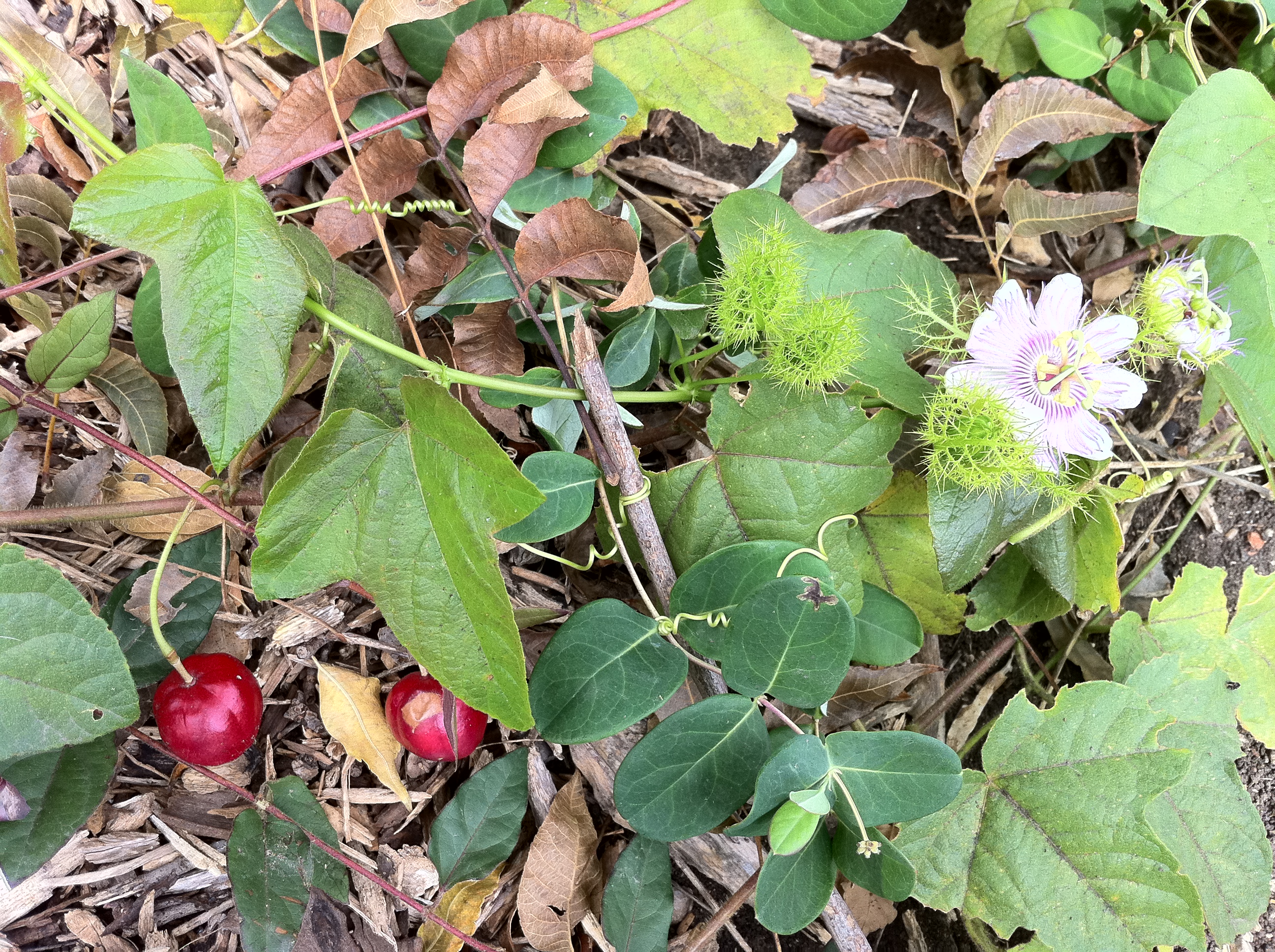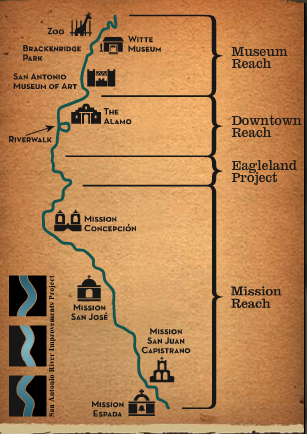Having spent the last year in Austin, I haven’t had the chance to check on my favorite public milkweed patch on the Museum Reach of the San Antonio River Walk as often as I’d like. Whenever I came to town over the last year and my husband and I found ourselves at the Pearl Brewery Farmer’s Market or enjoying a taco at La Gloria, we would wander down to the vast expanse of Asclepias tuberosa (native Butterflyweed and Monarch butterfly host) planted by the San Antonio River Authority (SARA) two years ago.

The Museum Reach Milkweed Patch on San Antonio River Walk in Dec. 2011, dwarf white Lantana in background
A visit upon my recent San Antonio homecoming left me grinning. A diverse population of butterflies flitted along the flowering stretch of river just south of the Pearl Brewery.
Monarchs, Sulphurs, Painted Ladies, Gulf Fritillaries–all nectared on native milkweed, lantana and passionflower vines, aerially skipping above the walkways and enchanting those lucky enough to bear witness. Even after hints of a first frost descended on San Antonio this week, the butterfly wildscape looked stunning–robust, healthy, and still showing flowers. Recent rains helped.

Passionflower and its fruit, the host plant to the Gulf Fritillary and Zebra Longwing, on the San Antonio River Walk
I’m not the only one delighted by the display. Benjamin Ahlburg, a five-year-old fellow butterfly fan and son of Trinity University’s President Dennis Ahlburg and Penelope Harley, relayed via email that a recent trot down the River Walk left him charmed.
“Mum, it really is a butterfly city,” he told his British mom in an accent worthy of Harry Potter. Tourists and passers-by parked themselves on benches to observe the butterfly festival, pronouncing it “lovely.”
Austin has Ladybird Lake and its incumbent urban charms–hipster-crowded running trails, kayaks and stand-up paddle boards for rent, and of course, the famous bat colony under the Congress Avenue bridge.
San Antonio’s River Walk has some of that, and more: a unique marriage of wild and urban. Venture north or south of the touristy downtown River Walk and enjoy publicly funded improvements that bring the wild aspects of South Texas into our downtown backyard. This urban wildscape befits San Antonio’s geographic location as “the funnel” of the Monarch Butterfly migration and as a crossroads for myriad butterfly species. And for home gardeners and those with acreage destined for a butterfly wildscape, our San Antonio River Walk provides proven inspiration for what works.
Two years after its installation during our historic Texas drought, the SARA’s $72.1 million Museum Urban Reach Segment extends 1.5 miles north from downtown, from Lexington Street to Josephine Street. The project is part of $358.3 million in San Antonio River improvements to restore the San Antonio River by Bexar County, the City of San Antonio, the U.S. Army Corps of Engineers (USACE), the San Antonio River Authority (SARA) and the San Antonio River Foundation.
And it gets better. South of downtown, the Mission Reach segment of the improvement project offers an even longer, more natural river walk all the way to Mission Espada. The undertaking will restore 334 acres of riparian woodland and includes the planting of more than 20,000 young trees and shrubs, 39 native tree and shrub species and more than 60 native grass and wildlife species. It’s already happening and vividly on display just south of The Blue Star Arts complex.
According to the Project website, when the restoration is complete,
“The native landscape will look wild rather than manicured. Grasses and wildflowers will be allowed to grow to their natural heights rather than mowed. Boat traffic on the river will be limited to canoes and kayaks rather than barges. The result will be a serene, natural landscape where visitors can enjoy the inherent beauty of the river.”
Hallelujah. More butterflies in our future.



Just “…south of the Pearl brewery.” I love it–beer and butterflies! What could be better? Sounds like the start of an excellent project. Hope everything continues on the same path. Ken
P.S. I love it when words like “riparian” sneak into discourse. I’ll have to trot it out as often as possible this next week. 😉
Ken, the Brewery is now defunct, but the beer lives on. You’ll have to come see it for yourself.
MM
I walked that portion of the Riverwalk, South of the Pearl Brewery, this last Wednesday (12/7), when it was quite chilly, but the Butterfly weed was blooming and it was wonderful to see the passionflower was going strong. Can’t beat this long, beautiful fall we’re having. And the butterflies agree. This part of the Riverwalk is a gem, so glad the city developed it.
Wendy, I couldn’t agree more. And when the Mission Reach is complete, even more butterflies will be moving to San Antonio. Thanks for stopping by.
MM
Wendy and Monika,
I just finished a walk there also. Love what they have done, but cannot wait for the museum reach to be completed. The above info says that it goes down to Mission Espada, but I saw machinery and workers all the way down to San Juan.
jessica leslie
The Museum reach is pretty much complete as best I can understand. The Mission Reach, however, is in process. I’m living down that way these days and walk my dog along the Eagleland extension every day. Next week I’ll be writing more about it. For more, see the official project site here: http://www.sanantonioriver.org/proj_facts/facts.php Thanks for stopping by and please check in next week.
MM
I know the attractions for many on the northern reach of the Riverwalk include the museums, hence the long accepted name “Museum Reach”. But this wonderful new attraction to our multi-cultural city deserves a more inviting name. Why not call the east side the “Mariposa (Butterfly) Walk” and the other the “Artisanos (Artisans) Walk”?
Works for me, Tony! Thanks for stopping by.
MM
[…] texasbutterflyranch we love the whole life cycle Skip to content HomeAbout the Texas Butterfly Ranch BlogResources ← San Antonio River Walk Boasts Vibrant “Butterfly City” Along Museum Reach as Butt… […]
[…] student Kelly Nail was pleasantly surprised at the bounty of butterfly life unfolding at the Museum Reach milkweed patch on the San Antonio River Walk just this week. The patch of Asclepias tuberosa, a native Texas […]
[…] student Kelly Nail was pleasantly surprised at the bounty of butterfly life unfolding at the Museum Reach milkweed patch on the San Antonio River Walk just this week. The patch of milkweed, a Monarch butterfly host […]
[…] student Kelly Nail was pleasantly surprised at the bounty of butterfly life unfolding at the Museum Reach milkweed patch on the San Antonio River Walk just this week. The patch of milkweed, a Monarch butterfly host […]